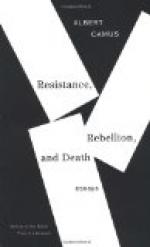In the opening chapter, which states the central problem, still slowly being worked out in the great series of The Golden Bough, Dr. Frazer has drawn the well-known picture of that haunted man. “The dreamy blue,” he writes:
“The dreamy blue of Italian skies, the dappled shade of summer woods, and the sparkle of waves in the sun, can have accorded but ill with that stern and sinister figure. Rather we picture to ourselves the scene as it may have been witnessed by a belated wayfarer on one of those wild autumn nights when the dead leaves are falling thick, and the winds seem to sing the dirge of the dying year. It is a sombre picture, set to melancholy music—the background of forest showing black and jagged against a lowering and stormy sky, the sighing of the wind in the branches, the rustle of the withered leaves under foot, the lapping of the cold water on the shore, and, in the foreground, pacing to and fro, now in twilight and now in gloom, a dark figure with a glitter of steel at the shoulder whenever the pale moon, riding clear of the cloud-rack, peers down at him through the matted boughs.”
For the priest himself it can hardly have been a happy life. Thanks to Dr. Frazer, we now partly know how much of man’s religious hope and fear that sinister figure represented. But he himself had no conception of all this, nor can we suppose that even if he had possessed Dr. Frazer’s own wealth of knowledge, it would have cheered him much. When violent death impends on every moment and lurks in every shade, it is small consolation to reflect that you stand as a holy emblem, protector of a symbolic tree, the mystic mate both of the tree itself and of the goddess of fertility in man and beast and plant. There is no comfort in the knowledge that the slave who waits to kill you, as you killed your predecessor in the office, only obeys the widespread injunction of primitive religion whereby the divine powers incarnate in the priest are maintained active and wholesome with all the fervour and sprightliness of youth. Such knowledge would not relax the perpetual strain of terror, nor could the priest have displayed an intelligent and scientific interest in all the queer mythologies forcibly dragged in and combined to explain his presence there—Orestes fleeing like a runaway from the blood-stained Euxine shore; or Hippolytus, faithful worshipper of the unwedded goddess, rent by wild horses, and by Diana’s prayer to the medicine-god subsequently pieced together into life; or Virbius, counterpart of Hippolytus; or perhaps even the two-faced Janus himself, looking before and after. The finest conjectures of research, though illustrated in the person of the priest himself, could have supplied him with no antidote to those terrors of ambushed assassination.




